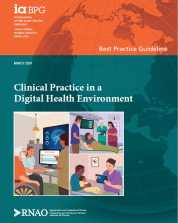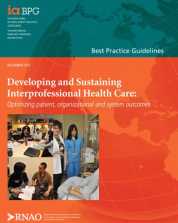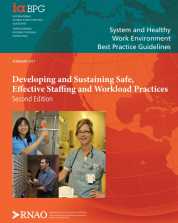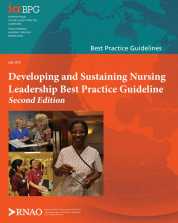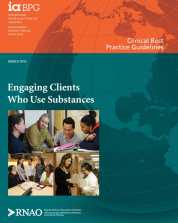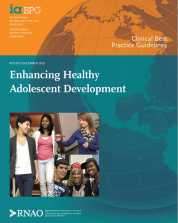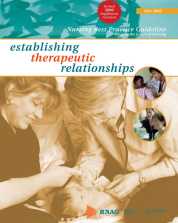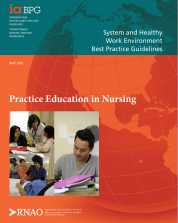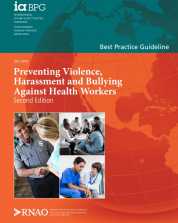The purpose of this best practice guideline (BPG) is to provide evidence-based individual, organization, education, and system/policy recommendations to: 1) enhance the capacity of all individuals involved in the implementation of an eHealth solution within a health care organization; 2) establish suitable infrastructures to support eHealth education needs; and, 3) facilitate technology-enabled health system transformation.
The purpose of this BPG is to foster nurses’ ability to maintain, advance, and strengthen professional practice in the
context of a digital health environment.
The purpose of this best practice guideline (BPG) is to foster healthy work environments.
The purpose of this best practice guideline (BPG) is to inform staffing and workload recommendations that can be implemented to benefit patients, nurses and other health-care providers, and organizations, as well as research, education, health-care policy, and systems. The goal of this guideline is to assist nurses, nursing leaders, and senior management groups across practice domains and settings to create healthy work environments through safe, effective staffing and workload practices.
The purpose of this best practice guideline is intended to assist nurses and others performing both formal and informal nursing leadership roles from the point-of-care to the board room, across a variety of practice domains and settings.
The purpose of this best practice guideline is to provide nurses and the interprofessional team across all care settings with evidence-based recommendations related to assessment and interventions for individuals aged 11 years and older who use substances and may be at risk for or experiencing a substance use disorder.
The purpose of this best practice guideline (BPG) is to assist nurses working with youth in a variety of practice settings, i.e. schools, public health units, community health centres, adolescent clinics, hospitals, and in family practice. Recommendations are inclusive of adolescent development across diverse contexts (e.g. cultural, socioeconomic, structural, political.)
The purpose of this best practice guideline (BPG) is to address the therapeutic relationship and its central importance to nursing practice. Effective nursing practice is dependent on an effective therapeutic relationship between the nurse and the client. The guideline addresses the qualities and capacities of an effective therapeutic relationship, the state of knowledge, and the knowledge needed to be effective in a therapeutic relationship.
The purpose of this best practice guideline (BPG) is to provide evidence-based recommendations that promote and sustain the undergraduate nursing student’s application of knowledge to practice in a variety of clinical learning environments. The guideline explores the relationships among and between students and nursing educators, nursing staff, preceptors and diverse health-care team members, and it considers their influence on the quality of practice education, professional socialization and nursing excellence.
The purpose of this best practice guideline (BPG) is to enhance the safety of health service organizations and academic institutions through the adoption of evidence-based practices. Safe and healthy work environments are an enabler for nurses and other health workers to optimize clinical outcomes for those receiving care. Such environments also optimize teaching and learning in academic settings. Specifically, the guideline will address how to recognize, prevent, and manage violence, harassment and bullying in the workplace.
